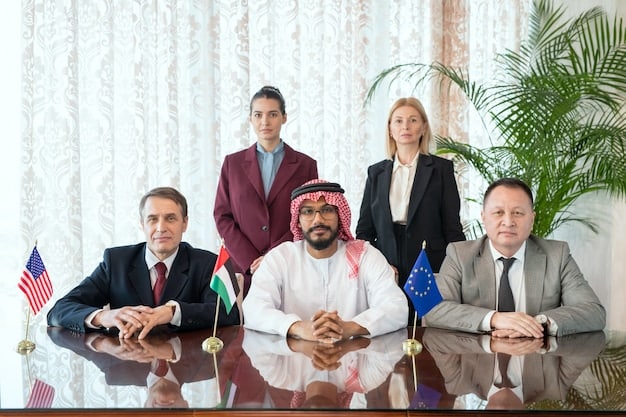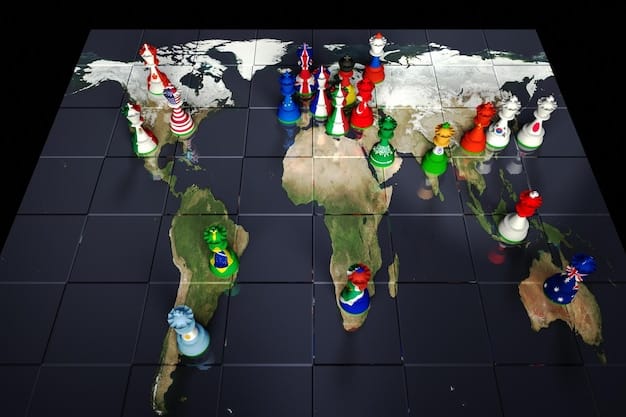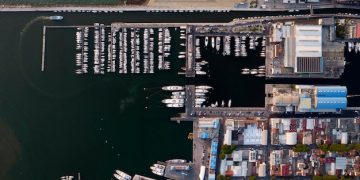US Diplomatic Efforts: Achieving Lasting Peace in the Middle East?

US diplomatic efforts in the Middle East aim to foster stability and resolve conflicts through negotiation, mediation, and strategic alliances; however, the complex geopolitical landscape and historical grievances pose substantial challenges to achieving a lasting peace agreement.
The Middle East remains a region fraught with conflict, political instability, and deep-seated historical grievances. US diplomatic efforts in the Middle East: Can a Lasting Peace Agreement Be Reached? is a critical question that warrants deep consideration, given America’s long-standing involvement and influence in the region.
The Historical Context of US Diplomacy in the Middle East
Understanding the current state of US diplomacy in the Middle East requires a look at the historical backdrop. The United States has been involved in the region since the early 20th century, initially focusing on oil interests and later expanding to include security concerns and geopolitical strategy.
Throughout the decades, US diplomacy has navigated a complex web of alliances, rivalries, and conflicts. From the Cold War competition with the Soviet Union to the more recent wars in Iraq and Afghanistan, the US has played a significant role in shaping the region’s trajectory.
The Early Years of US Involvement
The early involvement in the Middle East was largely driven by oil. As the world industrialized, the demand for oil grew, and the Middle East held vast reserves. This economic interest led to political and strategic considerations.
The Impact of the Arab-Israeli Conflict
The Arab-Israeli conflict has been a persistent focal point of US diplomacy. The US has attempted to mediate between Israelis and Palestinians, often struggling to balance its relationship with Israel and its desire for regional stability.
- The Camp David Accords in 1978 represents a significant diplomatic achievement, brokering peace between Israel and Egypt.
- The Oslo Accords in the 1990s aimed to create a framework for peace between Israel and the Palestinians but ultimately failed to achieve a lasting resolution.
- Numerous peace plans and initiatives have been proposed, but none have fully addressed the core issues of borders, security, and refugees.
These historical efforts highlight the complexities and challenges inherent in US diplomatic endeavors in the Middle East. Recognizing these past experiences is vital for shaping future strategies and approaches.
Key Players and Their Interests
The Middle East is a stage for numerous actors, each with their own interests and agendas. Understanding these players and their motivations is crucial for assessing the prospects of US diplomatic efforts in the Middle East: Can a Lasting Peace Agreement Be Reached?
From regional powers like Saudi Arabia, Iran, and Turkey to non-state actors such as Hezbollah and Hamas, the region is characterized by a complex and ever-shifting landscape of alliances and rivalries.

The Role of Saudi Arabia
Saudi Arabia, as a major oil producer and a leading Sunni Muslim country, plays a pivotal role in regional politics. The US has a long-standing strategic partnership with Saudi Arabia, focusing on security and economic cooperation.
The Influence of Iran
Iran, a Shia Muslim country, is a significant player with its own regional ambitions. US-Iran relations have been strained for decades, primarily due to Iran’s nuclear program and its support for various non-state actors.
Besides the regional powers, there are also external actors such as Russia and China that are increasingly involved in the Middle East. Their involvement adds another layer of complexity to the diplomatic landscape.
Understanding the key players and their interests is essential for the US to formulate effective diplomatic strategies and build alliances that promote stability and peace in the region.
Challenges Facing US Diplomacy
US diplomacy in the Middle East faces numerous challenges that complicate efforts to achieve lasting peace. These challenges range from deep-seated historical grievances to the rise of non-state actors and the involvement of external powers.
Navigating these challenges requires a nuanced understanding of the region’s complexities and a willingness to adapt diplomatic strategies to changing circumstances.
The Persistence of Historical Grievances
Historical grievances, such as the Arab-Israeli conflict and sectarian divisions, continue to fuel tensions in the Middle East. These grievances are deeply entrenched and difficult to overcome.
The Rise of Non-State Actors
Non-state actors, such as ISIS and al-Qaeda, pose a significant threat to regional stability. These groups operate outside the bounds of international law and often pursue violent agendas.
- The US has struggled to contain the influence of these groups, particularly in countries like Syria and Iraq.
- The rise of non-state actors has complicated diplomatic efforts, as these groups often reject negotiation and compromise.
- Counterterrorism efforts have become a central focus of US policy in the Middle East.
These factors highlight the need for US diplomacy to be adaptable and comprehensive, addressing both the symptoms and the root causes of conflict in the Middle East.
US Strategies for Peace and Stability
To effectively address the challenges in the Middle East, the US employs a range of strategies aimed at promoting peace and stability. These strategies include diplomatic engagement, security cooperation, and economic assistance.
The effectiveness of these strategies depends on their ability to address the underlying causes of conflict and to adapt to changing circumstances on the ground.
Diplomatic Engagement and Mediation
Diplomatic engagement is a cornerstone of US efforts to promote peace in the Middle East. This involves direct negotiations, mediation efforts, and participation in international forums.
Security Cooperation and Alliances
Security cooperation is another critical component of US strategy in the Middle East. The US maintains alliances with several countries in the region, providing military assistance and training to help them maintain security.

Several factors can undermine the effectiveness of US strategies. These include the lack of trust between different parties, the influence of external powers, and the persistence of internal conflicts within countries.
By adapting and refining these strategies, the US can continue to play a constructive role in promoting peace and stability in the Middle East.
Potential Future Scenarios
Looking ahead, several potential scenarios could shape the future of US diplomacy in the Middle East. These scenarios range from continued conflict and instability to the potential for a more peaceful and prosperous region.
Predicting the future is never easy, but by considering different possibilities and their implications, the US can better prepare itself to navigate the challenges and opportunities that lie ahead.
Continued Conflict and Instability
One potential scenario is a continuation of the current state of conflict and instability. This could involve ongoing wars, the rise of new extremist groups, and increasing competition between regional powers.
The Potential for a Broader Peace Agreement
Another scenario is the potential for a broader peace agreement between Israelis and Palestinians. This would require significant compromises on both sides and a willingness to address the core issues of the conflict.
The outcomes in the Middle East will depend on numerous factors, including the actions of regional and international actors, the willingness to compromise, and the ability to address the underlying causes of conflict.
By carefully considering these potential scenarios, the US can better prepare itself to navigate the complexities of the Middle East and to promote peace and stability in the region.
The Role of International Cooperation
Addressing the challenges in the Middle East requires international cooperation. No single country, including the United States, can solve the region’s problems alone.
Working with allies and partners, the US can leverage its resources and influence to promote peace, stability, and development in the Middle East.
The Importance of Multilateralism
Multilateralism, or working through international organizations such as the United Nations, can be an effective way to address complex challenges. These organizations provide a forum for countries to come together and find common ground.
The Role of Regional Organizations
Regional organizations, such as the Arab League and the Gulf Cooperation Council, also play an important role in promoting stability in the Middle East. These organizations can help to mediate disputes, promote economic cooperation, and address shared security challenges.
- The US can work with these organizations to support their efforts and to leverage their expertise and resources.
- International cooperation is essential for addressing the challenges in the Middle East.
- By working together with allies and partners, the US can promote peace, stability, and development in the region.
The interplay between regional and international actors is key to finding sustainable solutions to the complex problems plaguing the Middle East.
| Key Point | Brief Description |
|---|---|
| 🌍 Historical Context | US involvement since the 20th century, driven by oil and security interests. |
| 🤝 Key Players | Saudi Arabia, Iran, and non-state actors like Hezbollah influence regional dynamics. |
| ⚔️ Challenges | Historical grievances and the rise of non-state actors complicate US diplomacy. |
| 🕊️ Strategies | Diplomatic engagement, security cooperation, and economic assistance are key approaches. |
Frequently Asked Questions
▼
The primary goal is to foster stability and resolve conflicts through negotiation, mediation, and alliances. This aims to protect US interests and promote regional peace.
▼
Challenges include historical grievances, the rise of non-state actors, and complex geopolitical rivalries. These factors complicate efforts to achieve lasting peace and stability.
▼
Key players include Saudi Arabia, Iran, Turkey, and non-state actors like Hezbollah and Hamas. Each has its own interests and impact on the region’s stability.
▼
The US employs diplomatic engagement, security cooperation, and economic assistance. These strategies aim to address the root causes of conflict and promote economic development.
▼
International cooperation is essential. Working with allies and international organizations helps leverage resources and expertise to tackle complex issues and promote sustainable solutions.
Conclusion
In conclusion, US diplomatic efforts in the Middle East: Can a Lasting Peace Agreement Be Reached? remains a complex and ongoing challenge. The region’s intricate web of historical grievances, competing interests, and non-state actors necessitates a multifaceted approach involving diplomatic engagement, security cooperation, and economic assistance. While significant obstacles remain, the potential for a more peaceful and stable Middle East hinges on continued international cooperation and a commitment to addressing the root causes of conflict.





